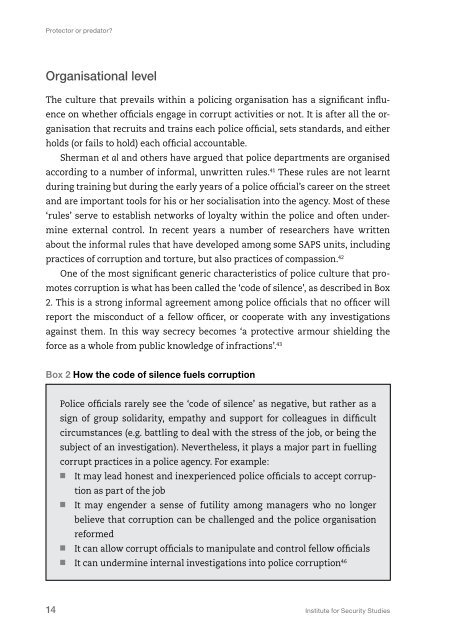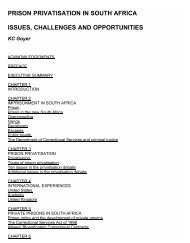Protector or predator? - Institute for Security Studies
Protector or predator? - Institute for Security Studies
Protector or predator? - Institute for Security Studies
You also want an ePaper? Increase the reach of your titles
YUMPU automatically turns print PDFs into web optimized ePapers that Google loves.
<strong>Protect<strong>or</strong></strong> <strong>or</strong> predat<strong>or</strong>?<br />
Organisational level<br />
The culture that prevails within a policing <strong>or</strong>ganisation has a significant influence<br />
on whether officials engage in c<strong>or</strong>rupt activities <strong>or</strong> not. It is after all the <strong>or</strong>ganisation<br />
that recruits and trains each police official, sets standards, and either<br />
holds (<strong>or</strong> fails to hold) each official accountable.<br />
Sherman et al and others have argued that police departments are <strong>or</strong>ganised<br />
acc<strong>or</strong>ding to a number of inf<strong>or</strong>mal, unwritten rules. 41 These rules are not learnt<br />
during training but during the early years of a police official’s career on the street<br />
and are imp<strong>or</strong>tant tools f<strong>or</strong> his <strong>or</strong> her socialisation into the agency. Most of these<br />
‘rules’ serve to establish netw<strong>or</strong>ks of loyalty within the police and often undermine<br />
external control. In recent years a number of researchers have written<br />
about the inf<strong>or</strong>mal rules that have developed among some SAPS units, including<br />
practices of c<strong>or</strong>ruption and t<strong>or</strong>ture, but also practices of compassion. 42<br />
One of the most significant generic characteristics of police culture that promotes<br />
c<strong>or</strong>ruption is what has been called the ‘code of silence’, as described in Box<br />
2. This is a strong inf<strong>or</strong>mal agreement among police officials that no officer will<br />
rep<strong>or</strong>t the misconduct of a fellow officer, <strong>or</strong> cooperate with any investigations<br />
against them. In this way secrecy becomes ‘a protective armour shielding the<br />
f<strong>or</strong>ce as a whole from public knowledge of infractions’. 43<br />
Box 2 How the code of silence fuels c<strong>or</strong>ruption<br />
Police officials rarely see the ‘code of silence’ as negative, but rather as a<br />
sign of group solidarity, empathy and supp<strong>or</strong>t f<strong>or</strong> colleagues in difficult<br />
circumstances (e.g. battling to deal with the stress of the job, <strong>or</strong> being the<br />
subject of an investigation). Nevertheless, it plays a maj<strong>or</strong> part in fuelling<br />
c<strong>or</strong>rupt practices in a police agency. F<strong>or</strong> example:<br />
■■<br />
It may lead honest and inexperienced police officials to accept c<strong>or</strong>ruption<br />
as part of the job<br />
■■<br />
It may engender a sense of futility among managers who no longer<br />
believe that c<strong>or</strong>ruption can be challenged and the police <strong>or</strong>ganisation<br />
ref<strong>or</strong>med<br />
■■<br />
It can allow c<strong>or</strong>rupt officials to manipulate and control fellow officials<br />
■■<br />
It can undermine internal investigations into police c<strong>or</strong>ruption 46<br />
14<br />
<strong>Institute</strong> f<strong>or</strong> <strong>Security</strong> <strong>Studies</strong>

















